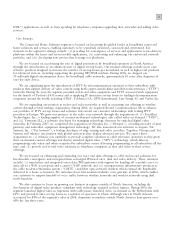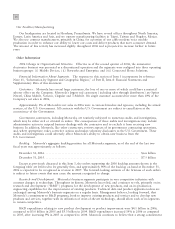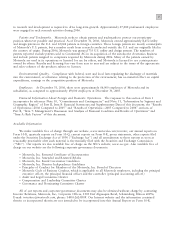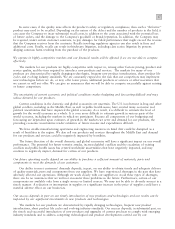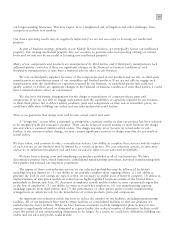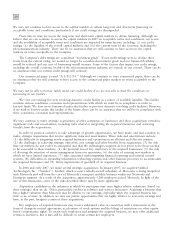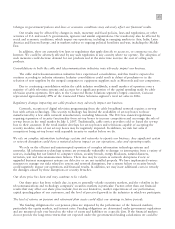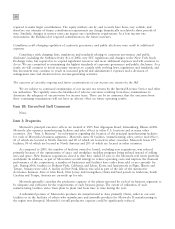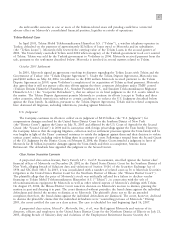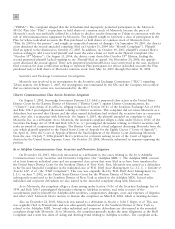Motorola 2006 Annual Report Download - page 27
Download and view the complete annual report
Please find page 27 of the 2006 Motorola annual report below. You can navigate through the pages in the report by either clicking on the pages listed below, or by using the keyword search tool below to find specific information within the annual report.
19
our longer-standing businesses. This may expose us to a heightened risk of litigation and other challenges from
competitors in these new markets.
Our future operating results may be negatively impacted if we are not successful in licensing our intellectual
property.
As part of business strategy, primarily in our Mobile Devices business, we strategically license our intellectual
property. Our existing intellectual property may not continue to generate sales and operating earnings at current
levels and we may not be successful at licensing new intellectual property.
Many of our components and products are manufactured by third parties and if third-party manufacturers lack
sufficient quality control or if there are significant changes in the financial or business condition of such
third-party manufacturers, it may have a material adverse effect on our business.
We rely on third-party suppliers for many of the components used in our products and we rely on third-party
manufacturers to manufacture many of our assemblies and finished products. If we are not able to engage such
manufacturers with the capabilities or capacities required by our business, or such third parties lack sufficient
quality control or if there are significant changes in the financial or business condition of such third parties, it could
have a material adverse effect on our business.
We also have third-party arrangements for the design or manufacture of certain products, parts and
components. If we are not able to engage such parties with the capabilities or capacities required by our business,
or these third parties fail to deliver quality products, parts and components on time and at reasonable prices, we
could have difficulties fulfilling our orders and our sales and profits could decline.
There is no guarantee that design wins will become actual orders and sales.
A ""design win'' occurs when a customer or prospective customer notifies us that our product has been selected
to be integrated with the customer's product. There can be delays of several months or more between the design
win and when a customer initiates actual orders. The design win may never become an actual order or sale.
Further, if the customer's plans change, we may commit significant resources to design wins that do not result in
actual orders.
We have taken, and continue to take, cost-reduction actions. Our ability to complete these actions and the impact
of such actions on our business may be limited by a variety of factors. The cost reduction actions, in turn, may
expose us to additional production risk and have an adverse effect on our sales and profitability.
We have been reducing costs and simplifying our product portfolios in all of our businesses. We have
discontinued product lines, exited businesses, consolidated manufacturing operations, increased manufacturing with
third parties and reduced our employee population.
The impact of these cost-reduction actions on our sales and profitability may be influenced by factors
including, but not limited to: (1) our ability to successfully complete these ongoing efforts; (2) our ability to
generate the level of cost savings we expect or that are necessary to enable us to effectively compete; (3) delays in
implementation of anticipated workforce reductions in highly-regulated locations outside of the United States,
particularly in Europe and Asia; (4) decreases in employee morale and the failure to meet operational targets due
to the loss of employees; (5) our ability to retain or recruit key employees; (6) our manufacturing capacity,
including capacity from third parties; and (7) the performance of other parties under contract manufacturing
arrangements on which we rely for the manufacture of certain products, parts and components.
An important cost-reduction action has been to reduce the number of our facilities, including manufacturing
facilities. All of our businesses have exited certain facilities or consolidated facilities so that our products are
manufactured in fewer facilities. While we have business continuity and risk management plans in place in case
capacity is significantly reduced or eliminated at a given facility, the reduced number of alternative facilities could
cause the period of any manufacturing disruptions to be longer. As a result, we could have difficulties fulfilling our
orders and our sales and profits could decline.




